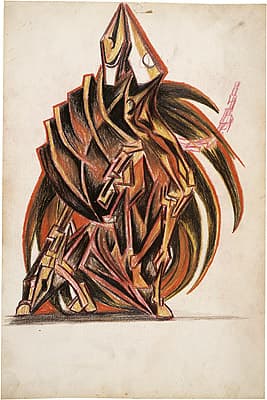
Jackson
POLLOCK
United States of America
1912
–
1956
Untitled
c. 1933-39
pencil, coloured crayon
on paper
OT 482
no inscriptions
sheet
38.2 (h)
x 25.5 (w)
cm
framed
58.5 (h)
x 43.2 (w)
cm
Purchased 1986
National Gallery of Australia, Canberra
NGA 1986.1047
© Pollock/Krasner Foundation/ARS. Licensed by Viscopy
- estate of the artist;
- estate of Lee Krasner Pollock;
- from whom bought, though Jason McCoy, New York on behalf of the Trustees of the Estate of Lee Krasner Pollock, by the Australian National Gallery, February 1986
- Jackson Pollock's Blue poles
- National Gallery of Australia 04 Oct 2002 – 27 Jan 2003
- Abstract Expressionism: the National Gallery of Australia celebrates the centenaries of Jackson Pollock and Morris Louis
- 14 Jul 2012 – 24 Feb 2013
- Eugene Thaw and Francis O'Connor, Jackson Pollock: Catalogue raisonné of paintings, drawings and other works, New Haven and London: Yale University Press 1978, cat. 482, p. 70, illus b&w;
- Anthony White (ed.), Jackson Pollock’s Blue poles, Canberra: National Gallery of Australia 2002, cat. 9, p. 117, illus. col. p. 89
Carl Jung’s theories were influential for many Surrealists and, in turn, for many Abstract Expressionists in shaping ideas about the creative capacity of the conscious and unconscious mind. It was Jungian psychology that encouraged the Surrealists to harness the imagery of their dreams and to experiment with mark-making techniques that freed the artist from conscious control over their creativity. From 1939 to 1940 Jackson Pollock was a patient of the Jungian psychologist Joseph Henderson. Over the course of 18 months, Pollock submitted 83 drawings to Henderson as material for analytical aids in Pollock’s therapy. The Gallery’s two works show a close association with Pollock’s ‘psychoanalytic drawings’, both in style and subject matter.
The earlier drawing, Untitled, produced between 1933 and 1939, is linked to both Cubism and Futurism in its exploration of movement, dynamism and energy through a multifaceted, linear form. Pollock’s depiction of an amalgamated figure that displays both horse and bird-like features is rendered in a garish palette of red, orange, yellow and brown. The modelling of form using the juxtaposition of light and dark and the overall emphasis on line, heightens the skeletal quality of the beast. The figure appears to be parading from left to right whilst throwing its head back. A curving tectonic form glides its way down the composition from the upper right, behind the beast’s neck and reveals itself again at the lower left, where it appears snake-like. The conjoining of two animals or an animal–human entity occurs frequently in Pollock’s drawings of this period. The image can be linked with his significant interest in Jungian iconography, including specific animals such as snakes, mandalas and shadows, which can be analysed as symbolic referents for such life forces as birth, death, power and failure.
In Untitled c.1939–42 the viewer is presented with the rump of a horse, shown in multiple views over several moments in time. The face of a bull appears at the lower left, looking directly at the viewer with a single yellow eye. Its enormous mass is rendered in orange and it appears conjoined with the horse into a condensed, almost vortex-like accumulation of small, short pencil strokes. Horse legs, hooves and heads are repeated, suggesting a frenetic movement that sweeps from the centre of the image and around, arcing across the composition from right to left. In the lower left corner, the horse figure dissipates into an array of empty eye sockets and skulls, finally coming to rest on the ground as a single white bone. This drawing, in particular, seems to evoke a life-and-death cycle, something that Pollock often symbolically explored in both his paintings and his drawings.
Aside from the Jungian references, a contemporaneous event adds an interesting perspective to the analysis of this later drawing: the display of Pablo Picasso’s seminal painting Guernica in New York at the Valentine Gallery in 1939. Read as homage to Picasso, Pollock’s reason for combining the bull and the horse becomes evident—both animals are used in Guernica as powerfully loaded symbols depicting the Fascist atrocities of the Spanish Civil War.
Jaklyn Babington
As well as the two paintings by Pollock, Totem lesson 2 1945 and Blue poles 1952, the National Gallery of Australia holds six drawings from the 1930s and 1940s, and two sets of prints: six intaglio prints c.1944, printed in1967, and six screenprints 1950.
